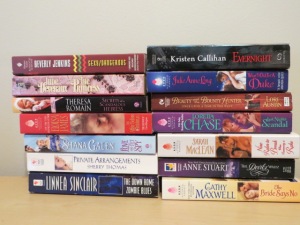As evidenced by the long gap between my last post and this one (over a year!), I’m not a very talkative blogger. I’m very private, and I struggle with what to say in a public forum, with what to reveal. This month marked a very personal, very private anniversary for me, and I’m finally ready to talk about it.
Thirteen years ago, I developed chronic pain that was eventually diagnosed as fibromyalgia. Ten years ago, I was diagnosed with endometriosis, a condition in which the material lining the uterus is found outside the uterus. It can cause horrible pain, but it was not the cause of my horrible pain. I was lucky in that aside from extreme exhaustion that had me struggling to stay awake on my 30-mile highway commute to work, no matter how much sleep I’d gotten the night before, I did not experience any of the typical symptoms of endometriosis. But my doctor, whom I’d only signed on with to undergo surgery to remove a big hairy cyst, assured me that he could treat my endometriosis and all of its pain.
You see, I’d woken from that surgery to discover my chronic pain had gone. I’d spent three years searching for a reason why I had constant, daily pain from my lower back to my ankles. Three years of visiting specialists, of tracking my pain, my activities, my food intake, to try to find a pattern. Three years of no answers and very little help from doctors. Of being told that as we get older, we develop pains. (I was in my mid-twenties!) Of being asked if I didn’t think it was all psychosomatic because I wasn’t loving my job (thanks for that, friend). Of questioning myself: maybe everyone was right and this was normal. But how could it be normal when it ruled my every waking thought and action? No, it was not normal. I refused to accept it. And now here I had a doctor telling me that if I didn’t take this drug for my endometriosis, all of my recently rid-of pain would come back.
I started taking this drug because I’d woken from surgery in a haze of “WTF just happened?” and “how did I get here?” Exhaustion aside, if not for some sharp, stabbing pains in my side three days prior, I never would have needed someone to root around my insides. It had been a wholly unexpected rollercoaster ride, and of course I trusted the doctor to know what he was doing. But once I started researching endometriosis and learning about it from other women who had it—once I started learning about this drug Lupron that I was taking, and experiencing dramatic mood swings of depression and violence and forgetfulness—I knew it was wrong for me. Still, I let myself be fear-mongered into taking another monthly shot. Because I did not want my chronic pain to return.
I cried in the doctor’s office as they gave me that shot of Lupron. It was something that I viscerally rejected. Every cell in me screamed no. But in the contest of fear versus fear, I did what the doctor said. Then the mood swings hit again and I yelled and screamed and shook my fists and feet at the dog, wanting nothing more than to beat her and beat her while she wanted nothing more than to care for me. To this day I don’t know how I managed not to hit my beloved pet. She wouldn’t leave my side, no matter how much I screamed and pushed at her (pushing her away, somehow, rather than hitting her), and she let me hug her when, moments later, my mood swung back and I cried in violent upset over what I had wanted to do to her.
Endometriosis comes back. Lupron is only approved by the FDA for twelve months of use in a lifetime. It was developed to treat prostate cancer, and in women it fucks with your hormones as it puts you into artificial menopause. No menses = no endo pain. But I never had endo pain, and I fired my doctor for his assumptions and his fear-mongering and his persistence in hugging me after every appointment. (It didn’t have a skeevy vibe to it, but dude was an ob-gyn. Of all doctors who should not be hugging patients…)
Through the endometriosis listserv I’d joined, I learned about the Center for Endometriosis Care. They specialize in this condition that most gyns learn about only glancingly in their studies. They review records for free. I traveled with my mother to Atlanta, Georgia, and the CEC for my next surgery. To this day, it remains the most positive medical and surgical experience of my life. The doctors there understand—everything—and they truly care, and it is because of Drs. Sinervo and Albee that I am ten years post-op and have never had more than a glimmer of fear that my endometriosis is back. I went from an 80% chance of recurrence with Dr. Huggy to a 20% chance of recurrence after treatment with a specialist using the excision technique (cutting out the endometriosis lesions instead of burning them away, which only gets at the surface of the problem).
Unfortunately, I woke from this surgery with a huge flare-up in my chronic pain. I also woke with renewed determination to deal with it. I knew it could be made to go away. I just needed to discover the way to make that happen. A few months after my surgery at the CEC, I noticed an article pinned to the board at my Pilates studio. It was about Muscle Activation Techniques, or MAT, which professional athletes were using to help them recover from injury more quickly and effectively. The process looks for where your strong muscles are overcompensating for the weak ones and rebalances the body. I left my first MAT session pain free.
The pain kept returning, but the periods of relief lasted longer, even if they weren’t entirely pain free. Not then. And I started to make connections between flare-ups and my activities. All that tracking I’d done for years finally started to pay off once I knew how my body was inclined to misalign itself. Through my MAT specialist and the insights and exercises she gave me, I became able to “fix” myself temporarily when I experienced a pain flare, although I needed some emergency sessions here and there when I messed things up badly. Regular MAT sessions have, over the course of ten years, finished what began with Dr. Sinervo and the Center for Endometriosis Care. They’ve given me back my life.
My chronic pain and endometriosis are inextricably intertwined. My endometriosis diagnosis confirmed that the chronic pain was not something I was imagining. It was real, and it had a source, and it could be made to go away. I was lucky that my endometriosis was mostly asymptomatic, and I’m luckier still that surgery with the CEC dealt with it. Recurrence can happen, even with excision. For me, excision surgery was the solution, and I’m grateful for all that that has meant in the years since.
Thirteen years ago I developed chronic pain. It ruled my life. In the years of recovery, I have struggled to loose myself of its grip. Only in this last year have I truly started to feel free.
Today my MAT sessions are for regular maintenance rather than treatment of chronic pain. I don’t think twice about what clothing to wear (will tighter jeans make my pain worse?), and while I worried a little about climbing halfway up the side of a mountain on last year’s vacation (huge opportunity for a pain flare), I did it anyway. Pain doesn’t sideline me anymore. I got some awesome photos, and a fantastic experience, and when the pain came, I fixed it and kept going.
I know now the reasons why this happens, and I cannot imagine a time when I’ll become so secure as to let my arsenal of defense dull its sharpened edges. But that doesn’t mean I won’t be climbing more mountains.




